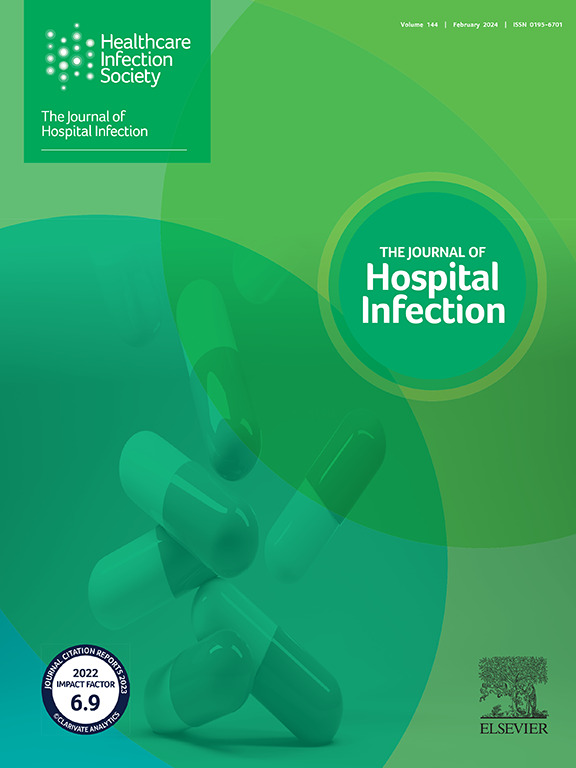Antimicrobial use in Japanese hospitals: results from a point-prevalence survey in Aichi, 2020
IF 3.9
3区 医学
Q1 INFECTIOUS DISEASES
引用次数: 0
Abstract
Background
Comprehensive antimicrobial use (AMU) data are essential to promote effective antimicrobial stewardship. However, qualitative information on AMUs in Japanese hospitals is limited.
Aim
To provide an overview of AMU for inpatients in Japanese hospitals.
Methods
A multi-centre point-prevalence survey was conducted across Aichi Prefecture in 2020, collecting patient demographics, underlying conditions, indications of AMU (for treatment of community-acquired infections (CAIs)/healthcare-associated infections (HAIs), surgical prophylaxis (SP), medical prophylaxis (MP) and others), treated infections, and antimicrobial stewardship team (AST) intervention.
Findings
Among the 10,199 patients from 27 hospitals included in this study, a total of 3738 antimicrobials were prescribed to 3024 patients (29.6%; 95% confidence interval: 28.8–30.5). Of these, 1510 (40.4%) antimicrobials were prescribed for CAI treatment, 815 (21.8%) for HAI treatment, 745 (19.9%) for SP, and 639 (17.1%) for MP. SP administration over 2 days was observed in 31.2% of the cases. The top three prescribed antimicrobials were cefazolin (12.0%, 450), ceftriaxone (9.2%, 343), and oral trimethoprim–sulfamethoxazole (8.7%, 327). AMU per 1000 patients was highest in extra-large hospitals (472) and lowest in small hospitals (264). Ceftriaxone was most commonly prescribed for CAIs, while meropenem was typical for HAIs. AST intervention rates were 15.0% and 22.5% in CAIs and HAIs, respectively.
Conclusion
This study provides comprehensive AMU information from a region in Japan, highlighting variations linked to hospital size, frequent prescriptions of broad-spectrum antimicrobials for HAIs, high prescription rate of trimethoprim–sulfamethoxazole as MP, and prolonged SAP.
日本医院抗菌素使用情况:爱知县2020年点状流行调查结果
背景:综合抗菌药物使用(AMU)数据对于促进有效的抗菌药物管理至关重要。然而,关于日本医院中激素的定性信息有限。目的:本研究旨在概述日本医院住院患者的急性脑损伤治疗情况。方法:于2020年在爱知县开展多中心点流行病学调查,收集患者人口统计学、基础疾病、AMU的适应症(用于治疗社区获得性感染[CAIs]/医疗保健相关感染[HAIs]、手术预防[SP]、医疗预防[MP]等)、治疗感染和抗菌药物管理团队(AST)干预。结果:在本研究纳入的27家医院10199例患者中,3024例患者共使用抗菌药物3738种(占29.6%;95%置信区间:28.8-30.5)。其中,1510种(40.4%)抗生素用于CAI治疗,815种(21.8%)用于HAI治疗,745种(19.9%)用于SP治疗,639种(17.1%)用于MP治疗。31.2%的病例服用SP超过2天。处方抗菌药物前三位分别是头孢唑林(12.0%,450人)、头孢曲松(9.2%,343人)和口服甲氧苄啶-磺胺甲恶唑(8.7%,327人)。每1 000名患者抗菌药物使用量在超大型医院最高(472例),在小型医院最低(264例)。头孢曲松是CAIs最常用的处方,而美罗培南是HAIs的典型处方。CAIs和HAIs的AST干预率分别为15.0%和22.5%。结论:本研究提供了来自日本某地区的综合AMU信息,突出了与医院规模、频繁使用广谱抗菌素治疗HAIs、甲氧苄啶-磺胺甲恶唑作为MP的高处方率以及持续的SAP相关的变化。
本文章由计算机程序翻译,如有差异,请以英文原文为准。
求助全文
约1分钟内获得全文
求助全文
来源期刊

Journal of Hospital Infection
医学-传染病学
CiteScore
12.70
自引率
5.80%
发文量
271
审稿时长
19 days
期刊介绍:
The Journal of Hospital Infection is the editorially independent scientific publication of the Healthcare Infection Society. The aim of the Journal is to publish high quality research and information relating to infection prevention and control that is relevant to an international audience.
The Journal welcomes submissions that relate to all aspects of infection prevention and control in healthcare settings. This includes submissions that:
provide new insight into the epidemiology, surveillance, or prevention and control of healthcare-associated infections and antimicrobial resistance in healthcare settings;
provide new insight into cleaning, disinfection and decontamination;
provide new insight into the design of healthcare premises;
describe novel aspects of outbreaks of infection;
throw light on techniques for effective antimicrobial stewardship;
describe novel techniques (laboratory-based or point of care) for the detection of infection or antimicrobial resistance in the healthcare setting, particularly if these can be used to facilitate infection prevention and control;
improve understanding of the motivations of safe healthcare behaviour, or describe techniques for achieving behavioural and cultural change;
improve understanding of the use of IT systems in infection surveillance and prevention and control.
 求助内容:
求助内容: 应助结果提醒方式:
应助结果提醒方式:


